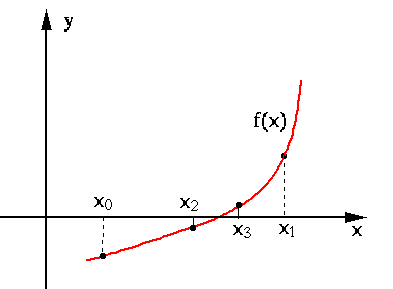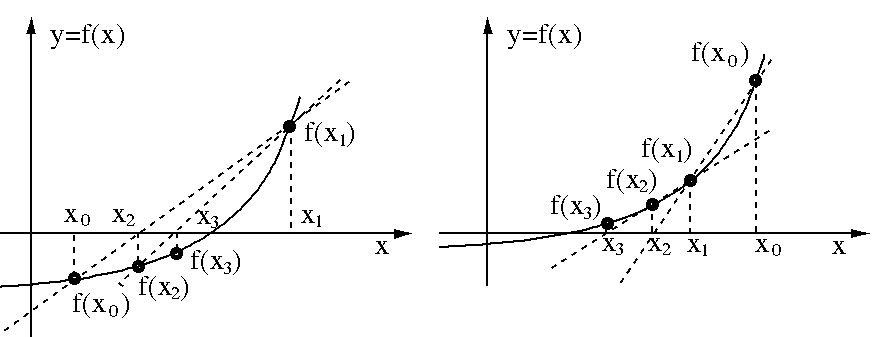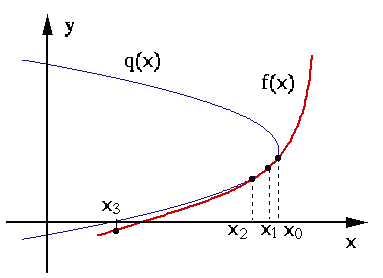Next: Solving equations by iteration Up: Solving Equations Previous: Solving Linear Equation Systems
Here we consider a set of methods that find the solution 


The bisection search
This method requires two initial guesses 








Given such two end points 









While any point between the two end points can be chosen for the
next iteration, we want to avoid the worst possible case in which
the solution always happens to be in the larger of the two sections




Here, without loss of generality, we have assumed



For example, we assume the root is located at 


 |
(12) |

Note that the error

 |
(13) |
 )
and the rate of convergence is
)
and the rate of convergence is  :
14
:
14
Compared to other methods to be considered later, the bisection method
converges rather slowly, but one of the advantages of the bisection
method is that no derivative of the given function is needed. This
means the given function 
The Secant method
Same as in the bisection method, here again we assume there are two
initial values 





At the zero crossing, 

 |
(16) |
 is the finite difference that approximates
the derivative
is the finite difference that approximates
the derivative  :
:
 |
(17) |
 obtained above, as a better estimate of the
root than either
obtained above, as a better estimate of the
root than either  or
or  , is used to replace one of them:
, is used to replace one of them:
 , then
, then
 satisfying
satisfying
 is replaced by
is replaced by  (same as the bisection
method);
(same as the bisection
method);
 , then
, then
 with greater
with greater
 is replaced by
is replaced by  .
.
 |
(18) |
In case






 |
(19) |
We now consider the order of convergence of the secant method. Let 


 |
 |
 |
|
 |
 |
(20) |
 :
:
 |
(21) |
 ) and similarly
) and similarly
 |
(22) |
 above we get
above we get
 |
 |
![$\displaystyle \frac{e_{n-1}[f'(x^*)e_n+\frac{1}{2}f''(x^*)e_n^2+O(e_n^3)]-e_n[f...
...x^*)e_n^2+O(e_n^3)]-[f'(x^*)e_{n-1}+\frac{1}{2}f''(x^*)e_{n-1}^2+O(e_{n-1}^3)]}$](img133.svg) |
|
 |
 |
||
 |
 |
||
 |
 |
(23) |
 , the lowest order terms in both the numerator
and denominator become the dominant terms as all other higher order terms
approach to zero, and we have
, the lowest order terms in both the numerator
and denominator become the dominant terms as all other higher order terms
approach to zero, and we have
 |
(24) |
 . To find the order of
convergence, we need to find
. To find the order of
convergence, we need to find  in
in
 |
(25) |
 we get
we get
 |
(26) |
 we also have
we also have
 |
(27) |
 |
(28) |
 |
(29) |
 |
(30) |
 |
(31) |
 |
(32) |
 and the order of convergence is
and the order of convergence is  , which
is better than the linear convergence of the bisection search (which
does not use the information of the specific function
, which
is better than the linear convergence of the bisection search (which
does not use the information of the specific function  ), but
worse than quadratic convergence of the Newton-Raphson method based
on the function derivative
), but
worse than quadratic convergence of the Newton-Raphson method based
on the function derivative  instead of the approximation
instead of the approximation
 , to be considered in the next section.
, to be considered in the next section.
The inverse quadratic interpolation
Similar to the secant method that approximates the given function 



In general, any function 




 |
(33) |
 to approximate the
inverse (horizontal) function
to approximate the
inverse (horizontal) function
 :
:
 |
(34) |
 , the corresponding
, the corresponding  is the zero-crossing of
is the zero-crossing of
 :
:
 |
(35) |
 of
of  . This expression
can then be converted into an iteration by which the next root estimate
. This expression
can then be converted into an iteration by which the next root estimate
 is computed based on the previous three estimates at
is computed based on the previous three estimates at  ,
,  ,
and
,
and  .
.

Brent's method
Brent's method combines the bisection method, secant method, and the method of inverse quadratic interpolation. In the iteration, a set of conditions is checked so that only the most suitable method under the current situation will be chosen to be used in the next iteration.